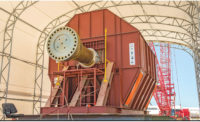Even before the crisis at Japan’s Fukushima Daiichi nuclear reactors has ended, nuclear industry experts from the U. S. are making plans to analyze and apply “lessons learned” from the accident triggered by an earthquake and tsunami.
Already, they are beginning to battle a backlash against nuclear power that threatens a revival of the nuclear industry: At least one U.S. company is facing serious questions over the feasibility of its nuclear project, politicians want a temporary moratorium on nuclear power, and financial analysts are downgrading prospects for firms with nuclear interests.
Worldwide, most countries are saying they will review their nuclear programs, and German Chancellor Angela Merkel announced on March 15 that her nation’s seven oldest nuclear powerplants will be shut down at least temporarily in the accident’s aftermath.
“I think we have already seen [what will happen]. Political reaction will be the first kind of wave. There will be a call for a moratorium on new plants until we understand what happened,” says Mike Wadley, vice president of Black & Veatch’s nuclear business. “What we will probably see is a step back as we initially look at the new plant designs.”
On March 15, Toyko Electric Power Co. was still fighting to contain overheating fuel in three oceanside reactors 140 miles northeast of Tokyo that lost their main source of power as well as their backup power following the March 11 magnitude-9.0 earthquake and ensuing tsunami. Without power, the fuel rods—which continue to produce heat—cannot be cooled. Japanese officials have said that there is a partial meltdown at the plant, meaning fuel has been exposed. A full meltdown, in which the containment is breached, is possible. TEPCO employees are trying to cool the fuel with seawater and said on March 15 that they were having some luck restoring power to the cooling system. Hydrogen buildup in the plants led to four explosions, and the International Atomic Energy Agency says that the explosion at Unit 2 may have affected the integrity of the reactor containment vessel.
Lloyd Cluff, director of earthquake risk management for Pacific Gas & Electric, which operates the Diablo Canyon nuclear powerplant on the Pacific Ocean at Avila Beach, Calif., already has been in touch with his counterparts in Japan and will travel this spring or summer to examine the plant, an exercise PG&E conducts after each earthquake, Cluff says.
Diablo Canyon and Southern California Edison’s San Onofre in San Diego County are the two U.S. nuclear plants at greatest risk for a Fukushima-like event as they both are in earthquake and tsunami zones. San Onofre is designed to resist an earthquake that registers a 7.0 on the Richter scale, and Diablo Canyon is designed to withstand a 7.5 quake, with a peak ground acceleration of .83. Diablo Canyon has the highest seismic standards of any plant in the world, Cluff says, because PG&E is constantly reevaluating its risks and design.
Cluff, the Nuclear Energy Institute and others in the industry insist the nation’s nuclear plants are designed to withstand any earthquake that might occur, but they also agree that self-examination following Fukushima is warranted. “Lessons learned is a hallmark of the nuclear industry,” Wadley says.
March 11 | Magnitude-9.0 earthquake strikes off the northeastern coast of Japan, knocking out power to the Fukushima Daiichi nuclear plants. Diesel generators, intended to provide backup electricity to the plant’s cooling system, are disabled by tsunami flooding that follows the quake. |
|---|---|
March 13 | Toyko Electric Power Co. is still fighting to contain overheating fuel in three reactors at the plant that lost its main and backup power. Without power, the fuel rods, which continue to produce heat, can’t be cooled. |
March 14 | Japanese officials say there is a partial meltdown at the plant, meaning fuel rods have been exposed. A full meltdown, in which the containment is breached, is possible. |
March 15 | TEPCO employees try to cool the fuel with seawater and return power to the plant. Hydrogen buildup in the plant triggers four explosions at the units. Officials say the Unit 2 blast may have compromised a reactor’s contain-ment integrity. Officials race to avoid meltdowns at three reactors. |
The focus shouldn’t be just on plant safety in a similar disaster but should acknowledge that the impossible can and does happen, said Peter Bradford, a former commissioner at the Nuclear Regulatory Commission and vice chairman of the Union of Concerned Scientists during a press briefing. “The challenge isn’t just whether [this] can be replicated somewhere else,” he said. “The next event may be a terrorist attack. It may be some other type of natural disaster.”
Jeffrey Merrifield, vice president of the power division of Baton Rouge-based The Shaw Group and a former NRC commissioner, says the agency,...








